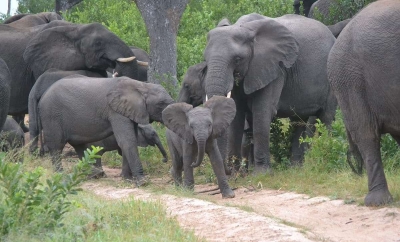
Classification
Elephants belong to the family Elephantidae, which also contains several extinct groups, including mammoths and straight-tusked elephants.
There are three different species of elephants – the African savannah elephant, the African forest elephant, and the Asian elephant. The savannah elephant is the largest of the three species- also the largest living terrestrial animal in the world.
Differences
- The easiest way to distinguish African elephants from their Asian cousins is to look at the ears. African elephants have larger ears that look like the continent of Africa, while Asian elephants have smaller, round ears. Asian elephants are smaller than African elephants.
- African elephants have concave backs, while Asian elephants have convex or level backs.
- Only some male Asian elephants have tusks, while both male and female African elephants grow tusks.
- African elephants live in sub-Saharan Africa, the rainforests of Central and West Africa, and the Sahel desert in Mali, while Asian elephants live in India, Nepal, Sri Lanka, and Southeast Asia in scrub forests and rainforests.
- There are minor differences between the African savannah elephant and the African forest elephant. The latter is a bit smaller than the former and has rounded ears. Forest elephants have tusks that are straight and point downward, while the savannah elephants have curved tusks.
Matriarchy
All three species are social and follow a matriarchal structure, with the eldest female elephant incharge of a herd. Herds consist of female family members and male offspring. Herds may include six to 20 members. Older males are often solitary.
The matriarch relies on her experience and memory to spot food, water, and shelter. Elephants in a herd build a strong bond by taking care of each other and protecting weak or injured members.
Intelligent animals
Elephants communicate using rumbling, low-pitched sounds that fall below the audible range of humans.
They demonstrate problem-solving skills, empathy, mourning, and self-awareness. Chasing, mounting, wrestling, and sparring are all considered part of play.
High Five
1. Wrinkles on an elephant’s skin trap moisture and keep the animal cool. That’s why African elephants have more wrinkles than their Asian counterparts.
2. African savannah elephants have four nails on the front feet and three on the back feet
African forest elephants have five nails on the front feet and four on the back feet Asian elephants have five nails on the front feet and four on the back feet
3. An elephant’s trunk is actually a fusion of its nose and upper lip, used for smelling, breathing, trumpeting, and drinking. Asian elephants have a single “finger” on the end of their trunks, while African ones have two.
4. Ivory tusks are actually massive teeth. They serve a variety of purposes: digging, stripping bark from trees to eat, and for defence. The tusks also protect the trunk. Did you know elephant tusks never stop growing?
5. Elephants use their big ears to cool themselves down when they are hot. The heat is released as they flap them about. Some scientists think that the ears may funnel sound into their inner ear for better hearing.
Ecological role of elephants
- As keystone species, they help maintain biodiversity of the ecosystems they inhabit. They shape their landscape, and allow other animals, plants, and birds to thrive.
- When elephants eat, they create gaps in the vegetation. These gaps allow new plants to grow and create pathways for other smaller animals to use. This way they also help trees disperse their seeds.
- Elephants dig waterholes on dry riverbed when rainfall is low. The waterholes are used by other wildlife as well.
- Elephant dung keeps the soil fertile and disperses seeds.
Eating, pooping, and mudbathing
- Elephants eat all types of vegetation, including a variety of grasses, plants, and fruits. They spend 12 to 18 hours of a day in eating. They consume about 75 to 150 kg of food per day. This means, they also excrete a lot. Each elephant creates one tonne of poop per week.
- Elephants love to play in the water and mud. After a river bath, they smear mud all over their bodies to cool themselves. Mud is also their sunscreen!
Threats to elephants
Poaching for illegal ivory trade, habitat loss, and human-animal conflict are the greatest threats to elephants. Infrastructure development such as roads, railways, and other constructions are not only leading to habitat fragmentation but also putting the parchydem in danger of accidents.
The International Union for Conservation of Nature and Natural Resources (IUCN) classifies the Asian elephant as endangered and the African elephant as vulnerable.
Picture Credit : Google




